 Sometimes it’s easy to feel as though it’s impossible to make much of a difference in a world as big and as fast-paced as our own. It’s also easy to slip into a sense of complacency and comfort ourselves with the thought that everyone is treated fairly in these modern times. Surely, the fights for civil rights and social justice were fought—and won—decades ago. But that’s not the case at all. Wars and violent conflicts continue to rage across the world, and injustices crop up on a daily basis, both at home and abroad. As the calendar indicates that the days have moved firmly into the second month of the year with the promise of spring in a few weeks, there is no better time to examine our own actions and those of others as well as taking a closer look at books that center on issues of social justice. This week’s books chosen by members of the International Reading Association's Children’s Literature and Reading Special Interest Group celebrate individuals and groups that make a difference, making them perfect choices for classroom read alouds or as discussion starters. Interested teachers may be interested in the World Day of Social Justice on February 20. ReadWriteThink offers a wide variety of lesson ideas using concepts of social justice. Additionally, the Jane Addams Book Awards website is a great place to find lists of books on concepts of peace and social justice. The Pirate Tree: Social Justice and Children’s Literature has a useful list as well.
Sometimes it’s easy to feel as though it’s impossible to make much of a difference in a world as big and as fast-paced as our own. It’s also easy to slip into a sense of complacency and comfort ourselves with the thought that everyone is treated fairly in these modern times. Surely, the fights for civil rights and social justice were fought—and won—decades ago. But that’s not the case at all. Wars and violent conflicts continue to rage across the world, and injustices crop up on a daily basis, both at home and abroad. As the calendar indicates that the days have moved firmly into the second month of the year with the promise of spring in a few weeks, there is no better time to examine our own actions and those of others as well as taking a closer look at books that center on issues of social justice. This week’s books chosen by members of the International Reading Association's Children’s Literature and Reading Special Interest Group celebrate individuals and groups that make a difference, making them perfect choices for classroom read alouds or as discussion starters. Interested teachers may be interested in the World Day of Social Justice on February 20. ReadWriteThink offers a wide variety of lesson ideas using concepts of social justice. Additionally, the Jane Addams Book Awards website is a great place to find lists of books on concepts of peace and social justice. The Pirate Tree: Social Justice and Children’s Literature has a useful list as well.
Grades K-3
Lyons, Kelly Starling. (2012). Hope’s gift. Illus. by Don Tate. New York: Penguin/G.P. Putnam’s Sons.
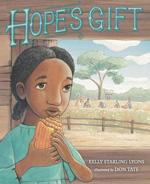 Released in time to celebrate the 150th anniversary of the Emancipation Proclamation, this story takes place in 1862 while the Civil War is raging. Hope and her enslaved family are kept working the cotton fields on a Southern plantation. After Papa has had enough on this particular Christmas Eve he decides to join the Union forces to fight for freedom. He leaves Hope and her brother Henry a conch shell and tells them to listen to the shell, and each time they hear the sounds within, they are to think of the sounds of freedom. That January 1, 1863, President Lincoln issues the Emancipation Proclamation. Though nothing much changes for Hope, Henry, and Mama, they continue to hope and pray for Papa’s safe return. As the war comes to end, one day they see a figure in a Union uniform come home, and it is Papa, ready to take them into the new and free life he fought so bravely to earn. Teachers may be interested in reading a letter from the author to her readers at the ReaderKidz blog.
Released in time to celebrate the 150th anniversary of the Emancipation Proclamation, this story takes place in 1862 while the Civil War is raging. Hope and her enslaved family are kept working the cotton fields on a Southern plantation. After Papa has had enough on this particular Christmas Eve he decides to join the Union forces to fight for freedom. He leaves Hope and her brother Henry a conch shell and tells them to listen to the shell, and each time they hear the sounds within, they are to think of the sounds of freedom. That January 1, 1863, President Lincoln issues the Emancipation Proclamation. Though nothing much changes for Hope, Henry, and Mama, they continue to hope and pray for Papa’s safe return. As the war comes to end, one day they see a figure in a Union uniform come home, and it is Papa, ready to take them into the new and free life he fought so bravely to earn. Teachers may be interested in reading a letter from the author to her readers at the ReaderKidz blog.
Hope’s Gift is also featured on The Brown Bookshelf blog.
- Karen Hildebrand, Ohio Library and Reading Consultant
McKissack, Patricia & Fredrick. (2013). Booker T. Washington: African American leader. Berkeley Heights, NJ: Enslow Elementary Publishers.
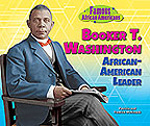 This brief biography provides basic facts about Booker T. Washington and his determination to gain an education. So keenly did he feel the need for book-learning that he held a job while attending school and walked great distances for the classes for which he signed up. Once he had his diplomas in hand, he wanted to offer the same possibilities to others since he considered education to offer a way out of poverty and despair. By working to provide a place where others could follow his lead and attain an education, he instilled hope in a brighter future for poor African Americans. Archival photographs and drawings add to the inspiring story of one man who refused to let poverty keep him from learning and succeeding.
This brief biography provides basic facts about Booker T. Washington and his determination to gain an education. So keenly did he feel the need for book-learning that he held a job while attending school and walked great distances for the classes for which he signed up. Once he had his diplomas in hand, he wanted to offer the same possibilities to others since he considered education to offer a way out of poverty and despair. By working to provide a place where others could follow his lead and attain an education, he instilled hope in a brighter future for poor African Americans. Archival photographs and drawings add to the inspiring story of one man who refused to let poverty keep him from learning and succeeding.
- Barbara A. Ward, Washington State University Pullman
McKissack, Patricia & Fredrick. (2013). Jesse Owens: Legendary track star. Berkeley Heights, NJ: Enslow Elementary.
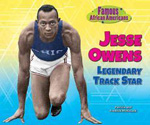 Despite his family’s poverty and his own health issues, Jesse Owens worked hard to overcome adversity. Eventually he grew up to become a track star, but he still faced the racism and prejudices of his times. Although Owens could run fast, earning a track scholarship at Ohio State University, he could not outrun the unfairness that surrounded him even during athletic events. That was particularly noticeable during the 1936 Olympics. The pressure was on Jesse when he represented the United States in Berlin since Adolph Hitler considered the Olympics as a proving ground for his belief in white supremacy. Much to the Nazi’s disappointment and to the delight of many African Americans, Jesse proved him wrong by winning four gold medals and breaking five world records in track. The book is divided into short chapters describing Jesse's journey and following him briefly after the glory of the Olympics faded. There are several photographs included in this introduction to a fascinating man who used his own fame to help others.
Despite his family’s poverty and his own health issues, Jesse Owens worked hard to overcome adversity. Eventually he grew up to become a track star, but he still faced the racism and prejudices of his times. Although Owens could run fast, earning a track scholarship at Ohio State University, he could not outrun the unfairness that surrounded him even during athletic events. That was particularly noticeable during the 1936 Olympics. The pressure was on Jesse when he represented the United States in Berlin since Adolph Hitler considered the Olympics as a proving ground for his belief in white supremacy. Much to the Nazi’s disappointment and to the delight of many African Americans, Jesse proved him wrong by winning four gold medals and breaking five world records in track. The book is divided into short chapters describing Jesse's journey and following him briefly after the glory of the Olympics faded. There are several photographs included in this introduction to a fascinating man who used his own fame to help others.
- Barbara A. Ward, Washington State University, Pullman
Nelson, Kadir. (2013). Nelson Mandela. New York: HarperCollins/Katherine Tegen Books.
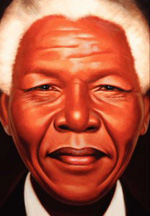 Kadir Nelson has once again created a children’s book masterpiece with his free verse writing and exquisite oil paintings on birch plywood illustrations, depicting the life of Nelson Mandela. Beginning with the full cover portrait of Mandela on the front and the title appearing on the back of the book, he tells the life story of Mandela, or Rolihlahla, his Xhosa name, which means troublemaker. It was a schoolteacher who gave him the name Nelson. As a bright child, Nelson was captivated by the stories of the village elders which taught him the history and exploitation of his country by Europeans. At the age of nine he leaves his village to get an education and eventually becomes a lawyer. While he is on his path to education he also experiences the injustices of apartheid and gets a close look at what is happening in his cruelly segregated country. His decision to become politically involved to end apartheid eventually leads to his arrest and 30 years in prison. Upon his release from prison years later, he again returns to the political scene to become the President of South Africa and lead his country into a state of equality. The book’s poetic prose does not describe all the difficulties Mandela encountered both politically and within his own personal life, instead focusing on the more philosophical journey of Mandela. The author notes at the end provide further back matter into Mandela’s life and triumphs. Teachers will want to visit Kadir Nelson’s webpage for a closer look at many of the illustrations in his new book or listen to this book summary on YouTube.
Kadir Nelson has once again created a children’s book masterpiece with his free verse writing and exquisite oil paintings on birch plywood illustrations, depicting the life of Nelson Mandela. Beginning with the full cover portrait of Mandela on the front and the title appearing on the back of the book, he tells the life story of Mandela, or Rolihlahla, his Xhosa name, which means troublemaker. It was a schoolteacher who gave him the name Nelson. As a bright child, Nelson was captivated by the stories of the village elders which taught him the history and exploitation of his country by Europeans. At the age of nine he leaves his village to get an education and eventually becomes a lawyer. While he is on his path to education he also experiences the injustices of apartheid and gets a close look at what is happening in his cruelly segregated country. His decision to become politically involved to end apartheid eventually leads to his arrest and 30 years in prison. Upon his release from prison years later, he again returns to the political scene to become the President of South Africa and lead his country into a state of equality. The book’s poetic prose does not describe all the difficulties Mandela encountered both politically and within his own personal life, instead focusing on the more philosophical journey of Mandela. The author notes at the end provide further back matter into Mandela’s life and triumphs. Teachers will want to visit Kadir Nelson’s webpage for a closer look at many of the illustrations in his new book or listen to this book summary on YouTube.
- Karen Hildebrand, Ohio Library and Reading Consultant
Smith, Charles R. (2013). Brick by brick. Illus. by Floyd Cooper. New York: HarperCollins/Amistad.
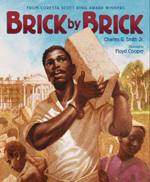 Building the White House in Washington, D.C. required the hands of many people to get the job done. In rhyming text complemented by the illustrations of Floyd Cooper, this team of Coretta Scott King Award winners tells the story of slaves, laborers, and the many people who worked side by side to complete the construction of the home of the new nation’s President. Slaves in chains, rented from Southern plantation owners, were part of the construction crew since workers were a shortage at this time. The skills learned in the building trade that many of these slaves acquired on the job eventually helped them to buy their way out of slavery and give them a way to earn a living in their newly-earned freedom. An outstanding feature of this book, in addition to the facts of this little known story, is the way the illustrator has painted the expressions on the faces of the people involved in the enormous building project. The sweat, the hard labor, and yet the pride in being part of this project combine with the expressions of hope for the future to make this an inspiring story to share. Smith has added a detailed historical note at the end to add further information. Readers will want to visit the author’s web page for news about his writing, activities and other resources for students.
Building the White House in Washington, D.C. required the hands of many people to get the job done. In rhyming text complemented by the illustrations of Floyd Cooper, this team of Coretta Scott King Award winners tells the story of slaves, laborers, and the many people who worked side by side to complete the construction of the home of the new nation’s President. Slaves in chains, rented from Southern plantation owners, were part of the construction crew since workers were a shortage at this time. The skills learned in the building trade that many of these slaves acquired on the job eventually helped them to buy their way out of slavery and give them a way to earn a living in their newly-earned freedom. An outstanding feature of this book, in addition to the facts of this little known story, is the way the illustrator has painted the expressions on the faces of the people involved in the enormous building project. The sweat, the hard labor, and yet the pride in being part of this project combine with the expressions of hope for the future to make this an inspiring story to share. Smith has added a detailed historical note at the end to add further information. Readers will want to visit the author’s web page for news about his writing, activities and other resources for students.
- Karen Hildebrand, Ohio Library and Reading Consultant
Tallec, Olivier. (2012). Waterloo and Trafalgar. Brooklyn, New York: Enchanted Lion Books.
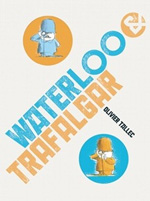 An editor’s opening note explains this French author/illustrator’s choice of the character names Waterloo and Trafalgar as being the two battle names that the French lost during the Napoleonic Wars. With orange for one character and blue for the other, the two military guards are on opposite sides of their walls where they keep constant vigil through their telescopes, all through the seasons of the year. Various little annoyances cause them to flare up and almost start shooting at one another. When a bird comes along and lays an egg that is speckled orange and blue, which eventually hatches into an orange and blue bird, reconciliation is in the air. Told wordlessly, this book is a tribute to visual storytelling as it presents the foolishness of war. Readers will want to listen to this French illustrator discuss his work on an international level on YouTube.
An editor’s opening note explains this French author/illustrator’s choice of the character names Waterloo and Trafalgar as being the two battle names that the French lost during the Napoleonic Wars. With orange for one character and blue for the other, the two military guards are on opposite sides of their walls where they keep constant vigil through their telescopes, all through the seasons of the year. Various little annoyances cause them to flare up and almost start shooting at one another. When a bird comes along and lays an egg that is speckled orange and blue, which eventually hatches into an orange and blue bird, reconciliation is in the air. Told wordlessly, this book is a tribute to visual storytelling as it presents the foolishness of war. Readers will want to listen to this French illustrator discuss his work on an international level on YouTube.
- Karen Hildebrand, Ohio Library and Reading Consultant
Tutu, Desmond. (2012). Desmond and the very mean word. Illus. by A.G. Ford. Somerville, MA: Candlewick Press.
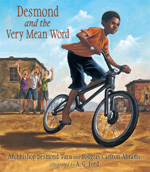 Using gentle language and avoiding the "mean word" that hurt him so deeply as a child in South Africa, Archbishop Desmond Tutu draws from his own life experiences for a lesson about forgiveness. While riding his new bike through a neighborhood, young Desmond is frightened by a group of boys who surround and heckle him, even calling him a name, thus spoiling his pleasure in the bike excursion. Even though his mentor, Father Trevor, advises him to forgive the bullies, Desmond feels unable to do so. After stewing over the injustice for a while, he fails to turn the other cheek, instead insulting the boy who called him a name the next time he sees him. After seeing the same boy picked on by his brothers later, Desmond’s conscience pricks him, and he eventually does the right thing. The story makes clear the ripple effect of our actions and the joy of choosing to forgive others. Pairing this title with Each Kindness (2012) by Jacqueline Woodson would add to its discussion possibilities. The facial expressions of the characters in the oil illustrations and the author's note providing information about the real Father Trevor offer readers much food for thought. This gentle rumination on forgiveness is a gentle reminder of the impact of our actions, large or small, on ourselves as well as on those around us. For more information, read "5 Questions With... Doug Abrams" (Tutu's co-author) on the Engage blog.
Using gentle language and avoiding the "mean word" that hurt him so deeply as a child in South Africa, Archbishop Desmond Tutu draws from his own life experiences for a lesson about forgiveness. While riding his new bike through a neighborhood, young Desmond is frightened by a group of boys who surround and heckle him, even calling him a name, thus spoiling his pleasure in the bike excursion. Even though his mentor, Father Trevor, advises him to forgive the bullies, Desmond feels unable to do so. After stewing over the injustice for a while, he fails to turn the other cheek, instead insulting the boy who called him a name the next time he sees him. After seeing the same boy picked on by his brothers later, Desmond’s conscience pricks him, and he eventually does the right thing. The story makes clear the ripple effect of our actions and the joy of choosing to forgive others. Pairing this title with Each Kindness (2012) by Jacqueline Woodson would add to its discussion possibilities. The facial expressions of the characters in the oil illustrations and the author's note providing information about the real Father Trevor offer readers much food for thought. This gentle rumination on forgiveness is a gentle reminder of the impact of our actions, large or small, on ourselves as well as on those around us. For more information, read "5 Questions With... Doug Abrams" (Tutu's co-author) on the Engage blog.
- Barbara A. Ward, Washington State University Pullman
Grades 4-8
Arkham, Thomas. (2013). Latino American civil rights. Broomall, PA: Mason Crest.
 From the Hispanic Americans series, this volume depicts the history and evolution of the civil rights of Latinos in America. Topics included are: What are civil rights, anyway?; Fighting for justice; Hispanic Americans over the year; Hispanic civil rights at work; Hispanic civil rights in the home; Hispanic civil rights and politics; Hispanic civil rights and education.
From the Hispanic Americans series, this volume depicts the history and evolution of the civil rights of Latinos in America. Topics included are: What are civil rights, anyway?; Fighting for justice; Hispanic Americans over the year; Hispanic civil rights at work; Hispanic civil rights in the home; Hispanic civil rights and politics; Hispanic civil rights and education.
- Karen Hildebrand, Ohio Library and Reading Consultant
Cheng, Andrea. (2013). Etched in clay: The life of Dave, enslaved potter and poet. New York: Lee and Low Books.
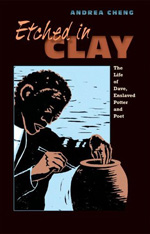 Written as historical fiction, this biography of Dave the Potter tells in beautiful fashion through poetic verse the story of this South Carolina slave and craftsman. Some of the poetry is the author’s and some of the lines are the inscriptions Dave himself crafted into his pottery. Setting the story in the early 1800’s, the author has pieced together the life of Dave as few facts or documents are available to provide actual information. According to the author’s research, it is believed that Dave was probably purchased at a slave auction in Georgia by Harvey Drake and taken to South Carolina to work at Pottersville near Edgefield, South Carolina. It is here that he learns the pottery business and is taught the use of the alkaline glazes created by the owners of the company. As Dave becomes a master potter he begins not only to sign his pots but adds inscriptions and poetry of his own. Because it was forbidden by law for slaves to learn to read or write, this was a brave but dangerous thing for Dave to do since it showed his defiance for a system that was unjust and wrong. Cheng’s own black and white woodcut illustrations, paired with her poetry alongside Dave’s provide a dramatic novelized biography of Dave the Potter. Dave the Potter (Laban Carrick Hill, 2010) is the perfect picture book companion to Cheng’s new book on the same topic. Using the two books together will create a lesson for readers to compare the information and artistic format used to tell Dave’s story. In addition, the publisher’s website offers a close reading lesson guide for Etched in Clay . Readers may also find a detailed teacher’s guide from Lee and Low.
Written as historical fiction, this biography of Dave the Potter tells in beautiful fashion through poetic verse the story of this South Carolina slave and craftsman. Some of the poetry is the author’s and some of the lines are the inscriptions Dave himself crafted into his pottery. Setting the story in the early 1800’s, the author has pieced together the life of Dave as few facts or documents are available to provide actual information. According to the author’s research, it is believed that Dave was probably purchased at a slave auction in Georgia by Harvey Drake and taken to South Carolina to work at Pottersville near Edgefield, South Carolina. It is here that he learns the pottery business and is taught the use of the alkaline glazes created by the owners of the company. As Dave becomes a master potter he begins not only to sign his pots but adds inscriptions and poetry of his own. Because it was forbidden by law for slaves to learn to read or write, this was a brave but dangerous thing for Dave to do since it showed his defiance for a system that was unjust and wrong. Cheng’s own black and white woodcut illustrations, paired with her poetry alongside Dave’s provide a dramatic novelized biography of Dave the Potter. Dave the Potter (Laban Carrick Hill, 2010) is the perfect picture book companion to Cheng’s new book on the same topic. Using the two books together will create a lesson for readers to compare the information and artistic format used to tell Dave’s story. In addition, the publisher’s website offers a close reading lesson guide for Etched in Clay . Readers may also find a detailed teacher’s guide from Lee and Low.
- Karen Hildebrand, Ohio Library and Reading Consultant
Delano, Marfe Ferguson. (2013). Master George’s people: George Washington, his slaves, and his revolutionary transformation. Illus. by Lori Epstein. Washington, DC: National Geographic.
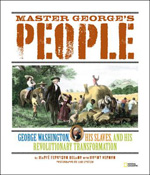 Filled with intriguing nuggets about how the nation’s first president changed his mind about the matter of slavery, this engaging nonfiction title relies on primary documents such as George Washington's papers and records to trace his radically evolving attitude. The author provides brief accounts of individuals who worked for Washington: Frank Lee, Washington's butler; Davy, an enslaved overseer; Hercules, the president's chef; Charlotte, the Mount Vernon seamstress; and William Lee, huntsman and personal servant. The few stories and names that are recorded and whose stories are told in this book will remind readers of lost lives and blighted futures as well as the cruel practices of selling slave family members to different owners. Photographs of historical interpreters at Mount Vernon add to the book's appeal and liveliness. There is even a poignant photograph of the slave burial ground on Washington's property. This slim volume packs an emotional punch and adds to the nation’s historical record.
Filled with intriguing nuggets about how the nation’s first president changed his mind about the matter of slavery, this engaging nonfiction title relies on primary documents such as George Washington's papers and records to trace his radically evolving attitude. The author provides brief accounts of individuals who worked for Washington: Frank Lee, Washington's butler; Davy, an enslaved overseer; Hercules, the president's chef; Charlotte, the Mount Vernon seamstress; and William Lee, huntsman and personal servant. The few stories and names that are recorded and whose stories are told in this book will remind readers of lost lives and blighted futures as well as the cruel practices of selling slave family members to different owners. Photographs of historical interpreters at Mount Vernon add to the book's appeal and liveliness. There is even a poignant photograph of the slave burial ground on Washington's property. This slim volume packs an emotional punch and adds to the nation’s historical record.
- Barbara A. Ward, Washington State University Pullman
Ford, Carin T. (2013). The Emancipation Proclamation, Lincoln, and slavery through primary sources. Berkeley, NJ: Enslow Publishers.
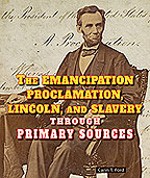 After providing historical context for the Civil War and how it occurred, the author relies on primary sources, including photographs and documents, to detail how President Abraham Lincoln came to write the Emancipation Proclamation, which freed slaves in the Southern states. The document helped show the world that the issue of slavery was at the center of the nation’s deep divisions. Filled with photographs and original documents, the book allows readers to focus on the impact of one important document whose effect rippled slowly but inexorably across the countryside.
After providing historical context for the Civil War and how it occurred, the author relies on primary sources, including photographs and documents, to detail how President Abraham Lincoln came to write the Emancipation Proclamation, which freed slaves in the Southern states. The document helped show the world that the issue of slavery was at the center of the nation’s deep divisions. Filled with photographs and original documents, the book allows readers to focus on the impact of one important document whose effect rippled slowly but inexorably across the countryside.
- Barbara A. Ward, Washington State University Pullman
Fradin, Judith Bloom and Dennis Brindell Fradin. (2013). The price of freedom: How one town stood up to slavery. Illus. by Eric Velasquez. New York: Walker Books for Young Readers.
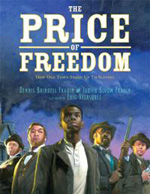 This always-reliable husband and wife research and writing team offer to young readers an incident from history known as the Oberlin-Wellington Rescue. In 1856, escaping slave John Price along with two other slaves crossed the Ohio River from Kentucky by means of the Underground Railroad. As Price made his way to Oberlin, Ohio, and found that he liked the people there, he stayed on and started a life for himself. In 1858, two years later, a group of slave hunters found him and tried to take him back to the South. However, the entire citizenry of Oberlin banded together, faced off the slave catchers, and refused to give up John Price. Velasquez’s mixed media and oil paints deftly portray the emotional confrontations that day. In double-page spreads and a page-by-page representation of the anti-slavery fever, the book shows how one community adamantly fought not only the slave catchers but also the law behind the Fugitive Slave Act of 1850. An interesting community comparison might be to look at Janice Cohn’s book, The Christmas Menorahs: How a Town Fought Fate (Whitman, 1995) to discuss how communities can band together to fight social injustice.An author’s note at the end of the book adds further information about this historical landmark action in the history of fighting slavery. Teachers might like to use a short text reading with archival photographs of the Rescuers provided by Oberlin College (Ohio) for an introduction to this book.
This always-reliable husband and wife research and writing team offer to young readers an incident from history known as the Oberlin-Wellington Rescue. In 1856, escaping slave John Price along with two other slaves crossed the Ohio River from Kentucky by means of the Underground Railroad. As Price made his way to Oberlin, Ohio, and found that he liked the people there, he stayed on and started a life for himself. In 1858, two years later, a group of slave hunters found him and tried to take him back to the South. However, the entire citizenry of Oberlin banded together, faced off the slave catchers, and refused to give up John Price. Velasquez’s mixed media and oil paints deftly portray the emotional confrontations that day. In double-page spreads and a page-by-page representation of the anti-slavery fever, the book shows how one community adamantly fought not only the slave catchers but also the law behind the Fugitive Slave Act of 1850. An interesting community comparison might be to look at Janice Cohn’s book, The Christmas Menorahs: How a Town Fought Fate (Whitman, 1995) to discuss how communities can band together to fight social injustice.An author’s note at the end of the book adds further information about this historical landmark action in the history of fighting slavery. Teachers might like to use a short text reading with archival photographs of the Rescuers provided by Oberlin College (Ohio) for an introduction to this book.
- Karen Hildebrand, Ohio Library and Reading Consultant
Lanthier, Jennifer. (2012). The stamp collector. Illus. by Francois Thisdale. Markham, ON: Fitzhenry & Whiteside.
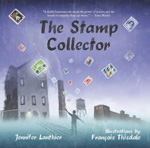 Readers will have to decide for themselves for what age group this book will be most effective. It is a beautifully illustrated book, with flowing text about the power of words and the consequences of written expression in some parts of the world. Two young boys living far apart in China and unknown to each other eventually have their lives intersect. The city boy finds a postage stamp when he is young, and from that moment, he envisions all the places a postage stamp can travel. In the meantime, the country boy has discovered reading and begins to write stories. As they grow up, the city boy continues his fascination with stamps but knows he has to earn a living and eventually takes a job as a prison guard. The country boy grows up to write a story about freedom, and one day gray men in uniforms lock him away in prison. It is here that the two, now grown men, meet. As the young prison guard watches the imprisoned writer spend each day feeling more and more despondent and growing weaker and weaker, as his cough worsens, he reaches out to the writer. The writer has been receiving letters from all over the world but has not been allowed to see them. The guard is fascinated with the stamps so he has carefully saved the letters in a box. As he watches the prisoner’s health decline, the guard begins to slip him a stamp or two … and then a few letters. With his last breaths, the prisoner tells the guard a story, which he writes down, completing the cycle. Based on the lives of two imprisoned political writers, this poignant story will prompt deep discussions. Teachers may want to use it with Antonio Skarmeta’s The Composition (Groundwood, 2003) for a comparative thematic discussion. The Stamp Collector has also been selected for the 2013 Outstanding International Books List sponsored by USBBY. A portion of the proceeds for this book will go to PEN Canada, which supports the Writers in Prison campaign.
Readers will have to decide for themselves for what age group this book will be most effective. It is a beautifully illustrated book, with flowing text about the power of words and the consequences of written expression in some parts of the world. Two young boys living far apart in China and unknown to each other eventually have their lives intersect. The city boy finds a postage stamp when he is young, and from that moment, he envisions all the places a postage stamp can travel. In the meantime, the country boy has discovered reading and begins to write stories. As they grow up, the city boy continues his fascination with stamps but knows he has to earn a living and eventually takes a job as a prison guard. The country boy grows up to write a story about freedom, and one day gray men in uniforms lock him away in prison. It is here that the two, now grown men, meet. As the young prison guard watches the imprisoned writer spend each day feeling more and more despondent and growing weaker and weaker, as his cough worsens, he reaches out to the writer. The writer has been receiving letters from all over the world but has not been allowed to see them. The guard is fascinated with the stamps so he has carefully saved the letters in a box. As he watches the prisoner’s health decline, the guard begins to slip him a stamp or two … and then a few letters. With his last breaths, the prisoner tells the guard a story, which he writes down, completing the cycle. Based on the lives of two imprisoned political writers, this poignant story will prompt deep discussions. Teachers may want to use it with Antonio Skarmeta’s The Composition (Groundwood, 2003) for a comparative thematic discussion. The Stamp Collector has also been selected for the 2013 Outstanding International Books List sponsored by USBBY. A portion of the proceeds for this book will go to PEN Canada, which supports the Writers in Prison campaign.
- Karen Hildebrand, Ohio Library and Reading Consultant
Rosenstock, Barb. (2012). The camping trip that changed America: Theodore Roosevelt, John Muir, and our national parks. Illus. by Mordicai Gerstein. New York: Penguin/Dial Books for Young Readers.
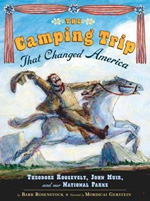 The vast network of national parks, protected areas, and beautiful nature reserves that survives in America today is mostly the work of one president and one famous naturalist. John Muir, who was born to immigrant farmers, hiked the wilderness alone and wrote about his travels. Although brought up in the city, President Theodore Roosevelt loved being in the outdoors. In March 1903, he happened to read Muir’s book calling on the federal government to save the nation’s trees. Roosevelt wrote to Muir with a request to have him take the President around the Yosemite wilderness. In May 1903, they rode horseback and camped in various places in the wilderness for four days. They visited the grove where giant sequoia trees grew, the glacier point, and finally reached the famous Yosemite Valley. The trip changed the President forever, inspiring him to work to create many national parks, wildlife sanctuaries, and national forests. The illustrations show the beauteous splendors of wild areas. This is a great book for use during units on natural history or conservation.
The vast network of national parks, protected areas, and beautiful nature reserves that survives in America today is mostly the work of one president and one famous naturalist. John Muir, who was born to immigrant farmers, hiked the wilderness alone and wrote about his travels. Although brought up in the city, President Theodore Roosevelt loved being in the outdoors. In March 1903, he happened to read Muir’s book calling on the federal government to save the nation’s trees. Roosevelt wrote to Muir with a request to have him take the President around the Yosemite wilderness. In May 1903, they rode horseback and camped in various places in the wilderness for four days. They visited the grove where giant sequoia trees grew, the glacier point, and finally reached the famous Yosemite Valley. The trip changed the President forever, inspiring him to work to create many national parks, wildlife sanctuaries, and national forests. The illustrations show the beauteous splendors of wild areas. This is a great book for use during units on natural history or conservation.
- Rani Iyer, Washington State University Pullman
Rubin, Susan Goldman. (2013). Diego Rivera: An artist for the people. New York: Abrams Books for Young Readers.
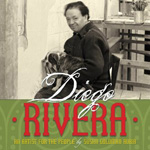 Filled with sumptuous samples of the famous Mexican artist's work, this book is an excellent introduction to Diego Rivera, a man whose appetite for life was as large as the large, colorful murals for which he became known. In text and in photographs, this biography traces how the man’s painting evolved over the course of his lifetime. Young readers will be interested in the influences on the art he created as well as how controversial and political some of it was considered. Almost larger than life in many respects and imperfect in many ways, Rivera was nevertheless clearly a genius and a visionary. Unlike many of his artistic predecessors who chose to paint wealthy clients and to paint for a more high-brow audience, Rivera drew his inspiration from the working class and poor citizens in his native country, often illustrating their struggle to make a living against tough odds. Additionally, he portrayed unsavory parts of his native country’s history, including its exploitation by Spanish conquerors. Although it's pretty near impossible to tell the artist’s story without mentioning his second wife, Frida Kahlo, the author focuses chiefly on Rivera and his many passions. Well-written, engaging and carefully designed, this biography is an excellent addition for a biography or art text set.
Filled with sumptuous samples of the famous Mexican artist's work, this book is an excellent introduction to Diego Rivera, a man whose appetite for life was as large as the large, colorful murals for which he became known. In text and in photographs, this biography traces how the man’s painting evolved over the course of his lifetime. Young readers will be interested in the influences on the art he created as well as how controversial and political some of it was considered. Almost larger than life in many respects and imperfect in many ways, Rivera was nevertheless clearly a genius and a visionary. Unlike many of his artistic predecessors who chose to paint wealthy clients and to paint for a more high-brow audience, Rivera drew his inspiration from the working class and poor citizens in his native country, often illustrating their struggle to make a living against tough odds. Additionally, he portrayed unsavory parts of his native country’s history, including its exploitation by Spanish conquerors. Although it's pretty near impossible to tell the artist’s story without mentioning his second wife, Frida Kahlo, the author focuses chiefly on Rivera and his many passions. Well-written, engaging and carefully designed, this biography is an excellent addition for a biography or art text set.
- Barbara A. Ward, Washington State University Pullman
Skrypuch, Marsha Forchuk. (2013). One step at a time: A Vietnamese child finds her way. Toronto, Ontario, CA: Pajama Press.
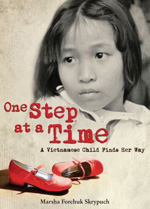 This companion book to Last Airlift: A Vietnamese Orphan’s Rescue from War (2012) provides the chapters that follow in the life of young Tuyet, a Vietnamese orphan stricken with polio and raised in a Vietnamese orphanage until her adoption by a Canadian family. As Tuyet becomes part of her new family, she also faces the surgeries that are required to repair her inward-turning foot. Unable to speak much English, the young girl is frightened by the hospital and surgical lights, the doctors, the consultations and examinations since she is still dealing with the nightmares of war-torn Vietnam and near-death experiences with guns and helicopters. As the surgeries conclude and the painful physical therapy begins, her new life starts to take shape. The cover of the book and the red shoes pictured take on a very special meaning by the end of this heart-warming book that will leave readers in tears. Teachers can read an interview with the author on the back matter for her book.
This companion book to Last Airlift: A Vietnamese Orphan’s Rescue from War (2012) provides the chapters that follow in the life of young Tuyet, a Vietnamese orphan stricken with polio and raised in a Vietnamese orphanage until her adoption by a Canadian family. As Tuyet becomes part of her new family, she also faces the surgeries that are required to repair her inward-turning foot. Unable to speak much English, the young girl is frightened by the hospital and surgical lights, the doctors, the consultations and examinations since she is still dealing with the nightmares of war-torn Vietnam and near-death experiences with guns and helicopters. As the surgeries conclude and the painful physical therapy begins, her new life starts to take shape. The cover of the book and the red shoes pictured take on a very special meaning by the end of this heart-warming book that will leave readers in tears. Teachers can read an interview with the author on the back matter for her book.
- Karen Hildebrand, Ohio Library and Reading Consultant
Grades 9-12
Lewis, J. Patrick. (2013). When thunder comes: Poems for civil rights leaders. Illus. by John Parra. San Francisco: Chronicle Books.
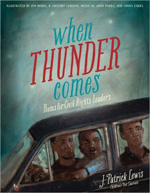 Social activism comes in different shapes and sizes, but when it comes, the changes it inspires spread across the social landscape just like the sonorous tones of thunder moving across the sky. NCTE Excellence in Poetry for Children recipient J. Patrick Lewis, the nation’s Children’s Poetry Laureate, has crafted fifteen poems celebrating the lives of seventeen social activists. Some of them, such as Coretta Scott King, Mohandas Gandhi, and Aung San Suu Kyi, will be familiar to readers while others, like Mitsuye Endo and Helen Zia, won't be as familiar. But they will gain some attention now, thanks to the efforts of Lewis to honor them through his words. Lewis uses his poetry to mine history for civil rights material, serving up poems such as "The Slugger" in celebration of baseball slugger Josh Gibson who never got the chance to play in baseball's major leagues because of the color barrier, and "The Child," which describes Mexican-Puerto Rican-American civil rights leader Sylvia Mendez who began fighting for the right to a high quality education when she was just a young girl. Her determination and the subsequent court case that her fight necessitated eventually paved the way for the better-known Brown v. Board of Education civil rights case heard by the Supreme Court in 1954. Filled with poetic snippets that illustrate the many ways the battle for civil rights has been fought across the world, not just this nation, this is another must-have literary treasure for any teacher wishing to integrate literacy with social studies while discussing the power of voice or one individual willing to stand up for his/her rights and the rights of others. The oil, acrylic, and watercolor illustrations add enormously to readers' enjoyment of the poems.
Social activism comes in different shapes and sizes, but when it comes, the changes it inspires spread across the social landscape just like the sonorous tones of thunder moving across the sky. NCTE Excellence in Poetry for Children recipient J. Patrick Lewis, the nation’s Children’s Poetry Laureate, has crafted fifteen poems celebrating the lives of seventeen social activists. Some of them, such as Coretta Scott King, Mohandas Gandhi, and Aung San Suu Kyi, will be familiar to readers while others, like Mitsuye Endo and Helen Zia, won't be as familiar. But they will gain some attention now, thanks to the efforts of Lewis to honor them through his words. Lewis uses his poetry to mine history for civil rights material, serving up poems such as "The Slugger" in celebration of baseball slugger Josh Gibson who never got the chance to play in baseball's major leagues because of the color barrier, and "The Child," which describes Mexican-Puerto Rican-American civil rights leader Sylvia Mendez who began fighting for the right to a high quality education when she was just a young girl. Her determination and the subsequent court case that her fight necessitated eventually paved the way for the better-known Brown v. Board of Education civil rights case heard by the Supreme Court in 1954. Filled with poetic snippets that illustrate the many ways the battle for civil rights has been fought across the world, not just this nation, this is another must-have literary treasure for any teacher wishing to integrate literacy with social studies while discussing the power of voice or one individual willing to stand up for his/her rights and the rights of others. The oil, acrylic, and watercolor illustrations add enormously to readers' enjoyment of the poems.
- Barbara A. Ward, Washington State University Pullman
Mullenbach, Cheryl. (2013). Double victory: How African American women broke race and gender barriers to help win World War II. Chicago: Chicago Review Press.
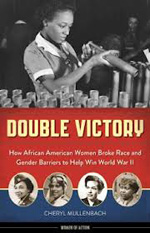 Rosie the Riveter became a popular WWII icon to represent all the women who entered the work force while men were fighting overseas. But Rosie does not really represent ALL the women. Double Victory provides a comprehensive look at the many African American women who had to overcome first prejudice and all kinds of discrimination in order to prove their worth in the war effort. This book examines not only the popular entertainers with familiar names such as Lena Horne but also other women whose names have gone unremarked. The book is divided into several sections: War Workers, Political Activists; Women in the Military, Volunteers, and Entertainers. These women served as journalists, war correspondents, Red Cross workers, pilots, nurses, factory workers, political activists and more. Interestingly, it was many of their brave and heartfelt deeds that led to increased civil rights efforts after the war. Quotations open each chapter, and archival photographs throughout the entire book add to the value of this book, which is indeed, a Double Victory in many ways and a new and valuable addition to women’s history, especially African American women. An epilogue, notes, and extensive bibliography and index are found at the end of the book.
Rosie the Riveter became a popular WWII icon to represent all the women who entered the work force while men were fighting overseas. But Rosie does not really represent ALL the women. Double Victory provides a comprehensive look at the many African American women who had to overcome first prejudice and all kinds of discrimination in order to prove their worth in the war effort. This book examines not only the popular entertainers with familiar names such as Lena Horne but also other women whose names have gone unremarked. The book is divided into several sections: War Workers, Political Activists; Women in the Military, Volunteers, and Entertainers. These women served as journalists, war correspondents, Red Cross workers, pilots, nurses, factory workers, political activists and more. Interestingly, it was many of their brave and heartfelt deeds that led to increased civil rights efforts after the war. Quotations open each chapter, and archival photographs throughout the entire book add to the value of this book, which is indeed, a Double Victory in many ways and a new and valuable addition to women’s history, especially African American women. An epilogue, notes, and extensive bibliography and index are found at the end of the book.
- Karen Hildebrand, Ohio Library and Reading Consultant
Pearsall, Shelley. (2012). Jump into the sky. New York: Random House/Alfred A. Knopf.
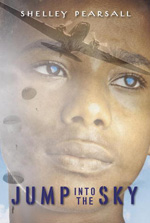 As WWII seems to be winding down in 1945, thirteen-year-old Levi Battle is sent South by the aunt with whom he has been living in Chicago. Aunt Odella has spent so much of her life taking care of others that she has little time for herself, and she has decided that it’s time for Levi’s father to do his duty by his son. Levi takes a train from Chicago to Washington, D.C., and then on North Carolina where his father is stationed. Along the way, he learns first-hand about segregation, prejudice, and hatred as he is forced to ride in a separate section of the train from the white passengers and realizes that in some places, even the simple act of buying a soft drink can have disastrous consequences. After Levi realizes that his father's squadron has relocated to Pendleton, Oregon, he is befriended by a kind-hearted couple, Cal and Peaches, who provide him with a home, and then bring him along when Cal also is sent to Pendleton to join the 555th Parachute Infantry Battalion, the nation's first African-American paratroopers. The initial encounters and relationship between father and son are every bit as bumpy as might be expected, but the author creates several likeable characters while telling the fictionalized story of a ground-breaking military unit. She manages to capture perfectly the flavor of those times and the different forms in which prejudice existed. Readers will be caught up in Levi’s journey and root for his story to have a happily ever after ending.
As WWII seems to be winding down in 1945, thirteen-year-old Levi Battle is sent South by the aunt with whom he has been living in Chicago. Aunt Odella has spent so much of her life taking care of others that she has little time for herself, and she has decided that it’s time for Levi’s father to do his duty by his son. Levi takes a train from Chicago to Washington, D.C., and then on North Carolina where his father is stationed. Along the way, he learns first-hand about segregation, prejudice, and hatred as he is forced to ride in a separate section of the train from the white passengers and realizes that in some places, even the simple act of buying a soft drink can have disastrous consequences. After Levi realizes that his father's squadron has relocated to Pendleton, Oregon, he is befriended by a kind-hearted couple, Cal and Peaches, who provide him with a home, and then bring him along when Cal also is sent to Pendleton to join the 555th Parachute Infantry Battalion, the nation's first African-American paratroopers. The initial encounters and relationship between father and son are every bit as bumpy as might be expected, but the author creates several likeable characters while telling the fictionalized story of a ground-breaking military unit. She manages to capture perfectly the flavor of those times and the different forms in which prejudice existed. Readers will be caught up in Levi’s journey and root for his story to have a happily ever after ending.
- Barbara A. Ward, Washington State University Pullman
Stone, Tanya Lee. (2013). Courage has no color: The true story of the Triple Nickles, America’s first black paratroopers. Somerville, MA: Candlewick.
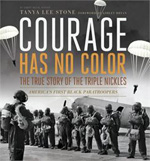 Ironically, while WWII was being waged to right the wrongs of Adolph Hitler’s Nazi Party, civil rights was only an idea whose time had not yet come back among the nation’s fighting men or back home. African American enlisted men often found themselves in segregated military units, and they were not allowed to fight. This engaging title tells the story of the Triple Nickels, the United States’ first black paratrooper battalion. The brainchild of First Sergeant Walter Morris, the unit allowed the men to feel a sense of pride that their contributions mattered, and proved that they could behave as courageously as their white counterparts. The book’s nine chapters provide historical context and explain the impact of racial stereotypes while also serving up an inspiring, little-known piece of history. The men’s voices, stories, and photographs make it clear that courage truly comes in all sizes, shapes, and colors.
Ironically, while WWII was being waged to right the wrongs of Adolph Hitler’s Nazi Party, civil rights was only an idea whose time had not yet come back among the nation’s fighting men or back home. African American enlisted men often found themselves in segregated military units, and they were not allowed to fight. This engaging title tells the story of the Triple Nickels, the United States’ first black paratrooper battalion. The brainchild of First Sergeant Walter Morris, the unit allowed the men to feel a sense of pride that their contributions mattered, and proved that they could behave as courageously as their white counterparts. The book’s nine chapters provide historical context and explain the impact of racial stereotypes while also serving up an inspiring, little-known piece of history. The men’s voices, stories, and photographs make it clear that courage truly comes in all sizes, shapes, and colors.
- Barbara A. Ward, Washington State University Pullman
Wilson, Diane Lee. (2012). Tracks. New York: Simon & Schuster/Margaret K. McElderry Books.
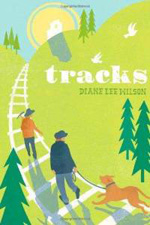 In order to provide for his family back home in New York City, Malachy Gormley heads west to find work doing whatever he can for the intercontinental railroad. The work is much harder and more dangerous than he ever imagined, and he finds solace in playing cards and spending time with Brina, the stray dog he has adopted, and Blind Thomas, a sturdy workhorse. Anger consumes Malachy, and he is angry at his father for dying, his mother for relying on him to pay the family's bills, and eventually himself for the wrong choices he makes. Among the laborers trying to tunnel through the steep mountains on the west coast are several Chinese men that the whites call Celestials. Malachy quickly notices Chun Kwok Keung since he is fearless when it comes to working with explosives and in resisting unfair practices. In fact, he leads the men in a fruitless strike for more pay. But Malachy’s anger and insecurity make him refuse the friendship Keung offers and causes him to join his comrades in making fun of the Chinese laborers. The author vividly depicts the harsh conditions of railroad building while also describing the prejudices of the 1860s. Brina functions as Malachy's conscience, looking at him in disappointment when he is thoughtless or cruel, but never forsaking him as he blunders through several costly decisions. The author’s vivid descriptions take her readers into the mountains and deserts through which the train tracks pass while offering hope for the future and for these two young men who turn out to have more in common than either of them might think.
In order to provide for his family back home in New York City, Malachy Gormley heads west to find work doing whatever he can for the intercontinental railroad. The work is much harder and more dangerous than he ever imagined, and he finds solace in playing cards and spending time with Brina, the stray dog he has adopted, and Blind Thomas, a sturdy workhorse. Anger consumes Malachy, and he is angry at his father for dying, his mother for relying on him to pay the family's bills, and eventually himself for the wrong choices he makes. Among the laborers trying to tunnel through the steep mountains on the west coast are several Chinese men that the whites call Celestials. Malachy quickly notices Chun Kwok Keung since he is fearless when it comes to working with explosives and in resisting unfair practices. In fact, he leads the men in a fruitless strike for more pay. But Malachy’s anger and insecurity make him refuse the friendship Keung offers and causes him to join his comrades in making fun of the Chinese laborers. The author vividly depicts the harsh conditions of railroad building while also describing the prejudices of the 1860s. Brina functions as Malachy's conscience, looking at him in disappointment when he is thoughtless or cruel, but never forsaking him as he blunders through several costly decisions. The author’s vivid descriptions take her readers into the mountains and deserts through which the train tracks pass while offering hope for the future and for these two young men who turn out to have more in common than either of them might think.
- Barbara A. Ward, Washington State University Pullman
These reviews are submitted by members of the International Reading Association's Children's Literature and Reading Special Interest Group (CL/R SIG) and are published weekly on Reading Today Online. The International Reading Association partners with the National Council of Teachers of English and Verizon Thinkfinity to produce ReadWriteThink.org, a website devoted to providing literacy instruction and interactive resources for grades K–12.